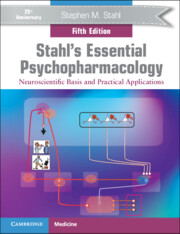Book contents
- Stahl’s Essential Psychopharmacology
- Additional material
- Stahl’s Essential Psychopharmacology
- Copyright page
- Contents
- Preface to the Fifth Edition
- CME Information
- 1 Chemical Neurotransmission
- 2 Transporters, Receptors, and Enzymes as Targets of Psychopharmacological Drug Action
- 3 Ion Channels as Targets of Psychopharmacological Drug Action
- 4 Psychosis, Schizophrenia, and the Neurotransmitter Networks Dopamine, Serotonin, and Glutamate
- 5 Targeting Dopamine and Serotonin Receptors for Psychosis, Mood, and Beyond: So-Called “Antipsychotics”
- 6 Mood Disorders and the Neurotransmitter Networks Norepinephrine and γ-Aminobutyric Acid (GABA)
- 7 Treatments for Mood Disorders: So-Called “Antidepressants” and “Mood Stabilizers”
- 8 Anxiety, Trauma, and Treatment
- 9 Chronic Pain and Its Treatment
- 10 Disorders of Sleep and Wakefulness and Their Treatment: Neurotransmitter Networks for Histamine and Orexin
- 11 Attention Deficit Hyperactivity Disorder and Its Treatment
- 12 Dementia: Causes, Symptomatic Treatments, and the Neurotransmitter Network Acetylcholine
- 13 Impulsivity, Compulsivity, and Addiction
- Suggested Reading and Selected References
- Index
5 - Targeting Dopamine and Serotonin Receptors for Psychosis, Mood, and Beyond: So-Called “Antipsychotics”
- Stahl’s Essential Psychopharmacology
- Additional material
- Stahl’s Essential Psychopharmacology
- Copyright page
- Contents
- Preface to the Fifth Edition
- CME Information
- 1 Chemical Neurotransmission
- 2 Transporters, Receptors, and Enzymes as Targets of Psychopharmacological Drug Action
- 3 Ion Channels as Targets of Psychopharmacological Drug Action
- 4 Psychosis, Schizophrenia, and the Neurotransmitter Networks Dopamine, Serotonin, and Glutamate
- 5 Targeting Dopamine and Serotonin Receptors for Psychosis, Mood, and Beyond: So-Called “Antipsychotics”
- 6 Mood Disorders and the Neurotransmitter Networks Norepinephrine and γ-Aminobutyric Acid (GABA)
- 7 Treatments for Mood Disorders: So-Called “Antidepressants” and “Mood Stabilizers”
- 8 Anxiety, Trauma, and Treatment
- 9 Chronic Pain and Its Treatment
- 10 Disorders of Sleep and Wakefulness and Their Treatment: Neurotransmitter Networks for Histamine and Orexin
- 11 Attention Deficit Hyperactivity Disorder and Its Treatment
- 12 Dementia: Causes, Symptomatic Treatments, and the Neurotransmitter Network Acetylcholine
- 13 Impulsivity, Compulsivity, and Addiction
- Suggested Reading and Selected References
- Index
Summary
This chapter explores drugs that target dopamine receptors, serotonin receptors, or both, for the treatment of psychosis, mania, and depression. It also explores myriad additional neurotransmitter receptors that these agents engage. The drugs covered in this chapter have classically been called “antipsychotics,” but this terminology is now considered out of date and confusing since these same agents are used even more frequently for mood disorders than for psychosis, yet are not classified as “antidepressants.” As mentioned earlier, throughout this textbook we strive to utilize modern neuroscience-based nomenclature, where drugs are named for their pharmacological mechanism of action and not for their clinical indication. Thus, drugs discussed in this chapter have “antipsychotic action” but are not called “antipsychotics”; they also have “antidepressant action” but are not called “antidepressants.” Instead, this chapter reviews one of the most extensively prescribed classes of psychotropic agents in psychiatry today, namely, those that target dopamine and serotonin receptors, and that began as drugs for psychosis, and later extended their use even more frequently as drugs for mania, bipolar depression, and treatment-resistant unipolar depression. On the horizon is the use of at least some of these agents in PTSD (posttraumatic stress disorder), agitation in dementia, and beyond. We discuss how the pharmacological properties of these agents form not only a single large class of many agents, but in many ways, how each individual agent has binding properties that render every agent unique from all the others. The reader is referred to standard reference manuals and textbooks for practical prescribing information because this chapter on drugs for psychosis and mood emphasizes basic pharmacological concepts of mechanism of action and not practical issues such as to how to prescribe these drugs (for that information, see, for example Stahl’s Essential Psychopharmacology: the Prescriber‘s Guide, which is a companion to this textbook).
- Type
- Chapter
- Information
- Stahl's Essential PsychopharmacologyNeuroscientific Basis and Practical Applications, pp. 159 - 243Publisher: Cambridge University PressPrint publication year: 2022



